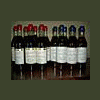What is the most important factor in a World Class Bourbon
This topic has been inactive for at least 365 days, and is now closed. Please feel free to start a new thread on the subject!
What is the Most Important Factor in a World Class Bourbon
56 members have voted
-
1. What is the Most Important Factor in a World Class Bourbon
-
Quality of Mash Components (Grain)3
-
Mash Bill / Composition (Percentage Corn, Rye, Wheat, Barley)4
-
Water1
-
Yeast1
-
Distillery Equipment / Process1
-
Age in Barrel2
-
Barrel Location7
-
Final Barrel Selection29
-
Blend of Barrels (If Not Single Barrel)4
-
Other4
-


Recommended Posts